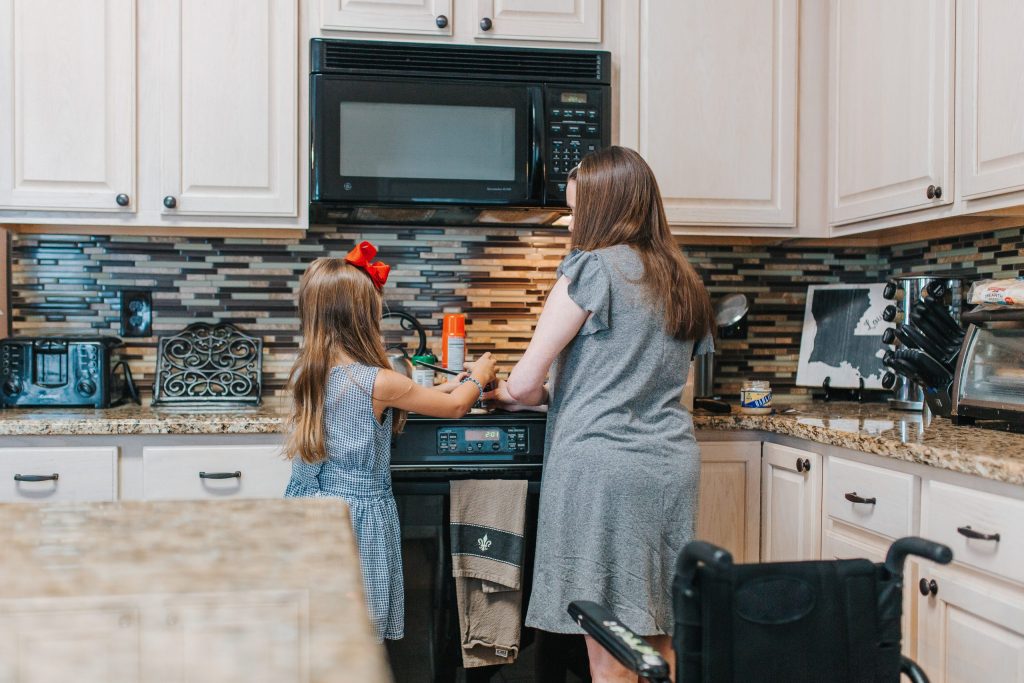May 9, 2022

After two years of working mostly from home, many workers (including United Way of the Alberta Capital Region staff) are starting to transition to a hybrid work arrangement – part time from the workplace and part time from a remote location.
Whether you are starting to get back into a regular in-person workplace routine or have been working out of home for the entire pandemic, big changes like this can affect our mental health. Be gentle with yourself and listen to others who may be having a tough time with this shift. By being empathetic, we can tune in with our own feelings. In turn, we’re able to be there for friends, family, and colleagues who need someone to talk to.
If you’re also navigating a work location transition, United Way team members have compiled some of their favourite tips, tricks, and tactics to share in hopes of making the adjustment smoother.

1. Reboot your daily routine
Returning to an in-person worksite means getting out the door on time. You might have to get up earlier in the mornings to account for your commute, making lunches, helping others get ready, and more. You also might wind up staying later than expected at the office, catching up with co-workers in the parking lot or getting stuck in traffic on the way home. Figuring out a consistent but realistic routine, both for office days and remote-work days, can help you plan ahead.
Take time to sit down and decide what will be on the menu for the upcoming week. Find meals that can be made the night before, are easy to prepare in 30 minutes or less, or can cook in a slow cooker during the day. Some people even choose to do all their cooking on their days off to have grab-and-go meals for the week.
On remote-work days, wake up at the same time as a commuting day to help build the habit, even if you don’t need the same amount of time to get ready. If it’s hard to get out of bed, find a reward to motivate yourself, like watching a favourite TV show or taking a few moments to enjoy a hot cup of coffee.
2. Enjoy your commute
While it might be hard to believe people enjoy being stuck in traffic or waiting for a bus, studies show that commuting can have a benefit: helping you break your day into work time and personal time.
Although travelling to work will take more time out of your day, try to find a way to enjoy it. Turn up your music, favourite podcast, or audiobook and take the opportunity to let go of the workday and focus on the rest of your evening — even more so if you take public transit. If possible, add in an active transportation element like riding your bike or walking.
If you’re working from home, create an alternate commute. Use the extra time to go for a walk, have a more leisurely breakfast, or read a book.

3. Plan for your wellness
All change, even a change we may be looking forward to, can present some challenges. While some people may be looking forward to connecting with their colleagues in person, others may feel hesitant.
Communicate with your supervisor or your peers about feelings you are experiencing. Chances are that you aren’t the only one who is apprehensive. If you aren’t quite ready for in-person meetings, ask for a hybrid option, or choose a seat that allows for a quick exit if you need to leave the room.
Being in a new setting may be distracting. Earplugs will block out distractions if there is background noise and headphones can help you focus on a virtual meeting, while also minimizing distractions for others.
If you’re feeling restless or anxious, having fidget toys, jewelry, pen and paper, or other objects you can hold or play with in your hands can help you relax. Similarly, others find that taking notes by hand during meetings helps them process information better.
4. Take frequent breaks
Be intentional with your breaks. Block time in your calendar for lunch and short breaks to protect that time from meeting requests. Likewise, a calendar desktop or smartphone app will remind you to take time to step away from work.
Go for regular walks, even if it’s just going to another part of your floor or building to use the washroom. Find a quiet space to decompress or meditate. If you are going to eat your lunch in your workspace, keep it in the fridge so you need to get up and go get it. Turn off your computer and find another activity you can do to take a break from your work.

5. Figure out logistics
To smoothly transition into a hybrid work mode, connect with your team to see what their preferences are for meetings. People who struggle with multi-tasking or context switching may consider structuring their days differently depending on where they’re working and what needs to be done. For example, if you prefer to do focused work in the office and have virtual meetings from home, schedule your office days when you don’t typically have a lot of meetings.
When arranging meetings, ask if attendees intend to attend in person or virtually, and schedule meeting rooms or set up virtual options accordingly. If you plan to be in virtual meetings or on the phone in a shared or open-concept workspace, consider booking a meeting room to ensure privacy and reduce distractions – for you and your co-workers.
Get comfortable in your workspace by adding art or décor. Bring in comfortable shoes or a blanket, especially since you may not be able to adjust the temperature. Add a plant or two to bring nature in and brighten your space with a pop of colour.
As working environments, commutes, and daily routines change, it’s natural that this shift to in-person or hybrid work may take some getting used to. Keep your mental health top of mind by giving yourself and your colleagues space and time to adjust to this transition.
If you need mental health support, 211 Alberta can help you find the right resources.